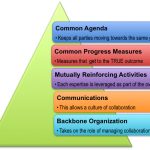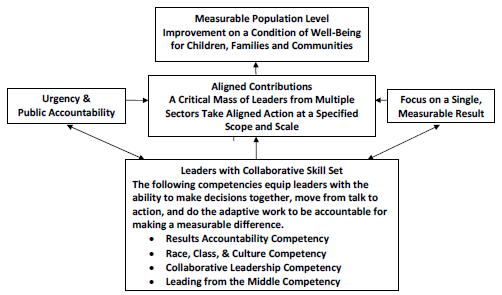Collective Leadership is a complex process, often described by many as “messy.” As a result, numerous theories and frameworks have emerged in recent years to guide leaders (Friedman, 2005; Kotter, 2007; Kania & Kramer, 2011), Meehan, 2010; Redding & Layland, 2017; Senge, 1995; Innovation Center for Community and Youth Development, 2012). Regardless of the specific approach, common elements can be found throughout. Most approaches utilize a systems thinking perspective and a results-based framework with the understanding Collective Leadership is both sequential and circular in its process. Several frameworks pertinent to Collective Leadership are described below:
 Kotter’s 8-Step Change Process
Kotter’s 8-Step Change Process
In Leading Change (1995), Harvard business school professor John Kotter introduced a framework involving an eight-step sequence for collectively executing and managing change. This sequence, referred to as the 8-Step Change Process for Leading Change, is relevant to any collective, results-oriented system, and is particularly helpful for leaders in early education as they move from vision to action for sustained change.
 Collective Impact Framework
Collective Impact Framework
The Collective Impact Framework (CIF) (Kania & Kramer, 2011) offers similar components for collectively leading change yet is unique in its reliance upon a Backbone Organization, citing the importance of a stable organizing entity. SEAs and LEAs are frequently in the position to serve as the Backbone Organization, placing greater opportunity and accountability for early education leaders in those organizations. In some states, other entities such as the State Early Childhood Advisory Council or Governor’s Office may serve this function. As described in the Organizational Leadership section of this Toolkit, the role of a Backbone Organization is instrumental.
 Shared Leadership Approach
Shared Leadership Approach
As individual leadership models shift toward collective leadership, the roles and responsibilities of leaders also shift. As the shared leadership pproach from the Leadership Learning Community highlights, there are implications as one shifts from an Executive Director (ED) approach. This shift can be particularly complex and vague for early education leaders who are held accountable for the results of a larger group over which they lack formal authority.
 Theory of Aligned Contributions
Theory of Aligned Contributions
An underlying model for Collective Leadership frameworks is the Theory of Aligned Contributions (Pillsbury, Goddard-Truitt, 2016) where multiple parties contribute to the achievement of a desired result in contrast to a traditional top-down executive director model. As seen by its central position in the figure below, aligned commitment and coordinated action of participating partners are crucial, regardless of any chosen framework.
Resources
- Common Purpose (Schorr, 2006)
- Theory of Aligned Contributions (Pillsbury & Goddard-Truitt, 2016)
- What does collective leadership look like in an organizational context? (Meehan, 2010)
- Understanding the Value of Backbone Organizations in Collective Impact (Stanford Social Innovation Review, 2012)
- The Leader’s New Work: Building Learning Organization (Senge, 1990)
- Strategic performance for your branch: Organizing people and their work in an LEA or SEA division or strand (Redding & Layland/BSPC, 2017
Activities
- The Collective Leadership Framework: A Workbook for Cultivating and Sustaining Community Change (Center for Ethical Leadership, 2007)
